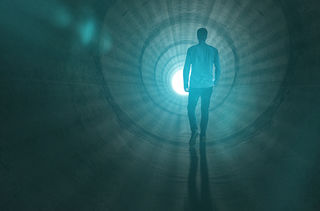Terror Management Theory
A Reflection on Near Death Experiences
How persuasive is the case for an afterlife based upon near death experiences?
Posted May 2, 2017 Reviewed by Matt Huston

Our brains have been designed through evolution to make it impossible to think of ourselves as not having consciousness, easily leading us down the road of thinking of our minds as being immortal. In fact, a group of psychologists have even identified the preoccupation with our own death as one of the driving forces in organizing the way we think. Their perspective is known as Terror Management Theory.
An admittedly superficial description of Terror Management Theory starts with the fact that humans are alone in the world in realizing that we will die someday, and this realization creates a terror that would make day-to-day living unbearable if it was allowed to fester. Consequently, anything that reminds us of our own mortality triggers an arsenal of defense mechanisms.
Perhaps the most terrifying thing about death is its ambiguity. All of our religious beliefs notwithstanding, no one knows for sure what happens to us after we die, and our thirst for any information about this appears to be unquenchable.
Hence, our fascination with Near Death Experiences, or “NDEs” for short.
How better to learn something of value about death than by looking to those individuals who have apparently crossed over and then returned to us?
The NDE is often considered to be the most persuasive bit of evidence for the continuation of life after physical death. It is similar to other “out of body” experiences such as the commonly reported phenomenon of hospital patients under anesthesia floating near the ceiling as they watch their own surgeries. Such out-of-body experiences can also be triggered artificially through electrical stimulation of certain brain regions. However, the near death experience is much more extreme. People not only experience a leaving of their bodies; they may be transported into a completely different world.
Near death experiences have been reported throughout human history, but they seem to be more common today, probably because of the medical technology available in 21st century hospitals. Sir William Barrett made one of the first attempts to understand NDEs scientifically, and accounts of his findings were published in his book Death-Bed Visions in 1926. However, the expression “near death experience” was introduced in popular usage by an American physician named Raymond A. Moody Jr. in his book Life after Life in 1975. Moody had interviewed hundreds of people who had experienced NDEs, and he was struck by the amazing consistency reported by this very diverse group of individuals. His conclusions have since been corroborated by other investigators, with approximately half of people who have “died” of a heart attack reporting experiences much like the classic NDE.
Not all individuals who experience a NDE report exactly the same combination of events, but their accounts are similar enough for us to describe a “typical” near death experience. My description draws heavily on accounts of the near death experience from other authors.

The unfolding of the NDE coincides with the beginnings of the person slipping away from life. He or she often can still hear the voices of the living individuals surrounding them, but these fade as the person slips into a long dark tunnel full of loud ringing or buzzing sounds. Occasionally, they report being able to see their own body from a distance as the drama unfolds. The newly dead individual may or may not encounter previously deceased friends or relatives, but there is commonly an encounter with a “being of light.” Sometimes, this being of light morphs into a religious figure, sometimes not. There is frequently a review and evaluation of the events of the person’s life via a “shared understanding” with the being of light. At some point, the dead individual encounters an obstacle of some sort that prevents the complete transit of the tunnel, and the person is forced to return to his or her body and mortal life. Throughout the entire experience, a rapturous sense of serenity and bliss envelops the individual.
Universally, NDE sojourners confirm the very real and vivid nature of the experience. It is nothing at all like a dream or a memory, they all agree—it is instead the most intense sensory experience they have ever encountered.
The person’s cultural or religious background does not seem to strongly influence the sequence or intensity of the NDE events, but it does dictate the interpretation given to the experience upon his or her return to this world.
For the believer, the explanation is simple—the person’s soul has departed from the body and traveled toward heaven or wherever their presumed final destination may be. They have also encountered God, or at least an angel or other divine being.
For the skeptic, as usual, things are not so simple. Even the most cold-hearted of skeptics accepts the sincerity of the reports made by individuals who have had near death experiences, and the profound impact of the experience on these individuals cannot be denied. However, a careful examination of even the most convincing NDEs leaves open multiple plausible interpretations.
It is not at all surprising that individuals’ subjective responses to oxygen depletion and the orderly shutting down of internal organs would be highly similar from person to person. And, we must remember that none of these individuals were actually dead. It is now recognized that precise identification of the moment of death is difficult, and just because a pulse and breathing have stopped does not mean that the person is beyond revival. Furthermore, experiences very much like NDEs have been reported by people experiencing migraines or epileptic seizures and by those under the influence of hallucinogenic drugs; no one attributes these experiences to supernatural or spiritual causes.
In the end, we are left with the tension that is inherent in so many paranormal experiences: vivid subjective experience and intuition versus a rational analysis of data and competing explanations. We should not allow our desire to believe in something to interfere with our ability to critically examine evidence.
References
Barrett, W. (1926). Deathbed Visions. UK: White Crow Books.
Bering, J. (2002). Intuitive conceptions of dead agents’ minds: The natural foundations of afterlife beliefs as phenomenological boundary. Journal of Cognition and Culture, 2, 263-308.
Bering, J. (2008). The end? Why so many of us think our minds continue after we die. Scientific American Mind, October/November, 34-41.
Bering, J. (2006). The cognitive psychology of belief in the supernatural. American Scientist, 94, 142-149.
Blackmore, S. (1996). Near-death experiences: In or out of the body? In J. Nickell, B. Karr, & T. Genoni (Eds.), The outer edge: Classic investigations of the paranormal (pp. 86-97). Amherst, NY: Committee for the Scientific Investigation of Claims of the Paranormal (CSICOP), Inc.
De Ridder, K., et al. (2007). Visualizing out-of-body experience in the brain. New England Journal of Medicine, 357, 1829-1833.
Ebbern, H., Mulligan, S., & Beyerstein, B. L. (2000). Maria’s near-death experience: Waiting for the other shoe to drop. In Bizarre Cases (pp. 148-161). Amherst, NY: Committee for the Scientific Investigation of Claims of the Paranormal (CSICOP), Inc.
Grant, J. (2015). Spooky science: Debunking the pseudoscience of the afterlife. New York: Sterling Publishing Company.
Greenberg, J., Pyszczynski, T., & Solomon, S. (1986) The causes and consequences of a need for self-esteem: A terror management theory. In Public self and private self, (pp. 189-212). New York: Springer.
Greenberg, J., Solomon, S., & Pyszczynski, T. (1997). Terror management theory of self-esteem and cultural worldviews: Empirical assessments and conceptual refinements. Advances in Experimental Social Psychology, 29, 61-139.
Moody, R. A. Jr. (1975). Life After Life. San Francisco: HarperCollins.
Pyszczynski, T., Greenberg, J., & Solomon, S. (1999). A dual-process model of defense against conscious and unconscious death-related thoughts: an extension of terror management theory." Psychological Review, 106, 835-845.
Solomon, S., Greenberg, J., & Pyszczynski T.(1991). A terror management theory of social behavior: The psychological functions of self-esteem and cultural worldviews." Advances in Experimental Social Psychology, 24, 93-159.




